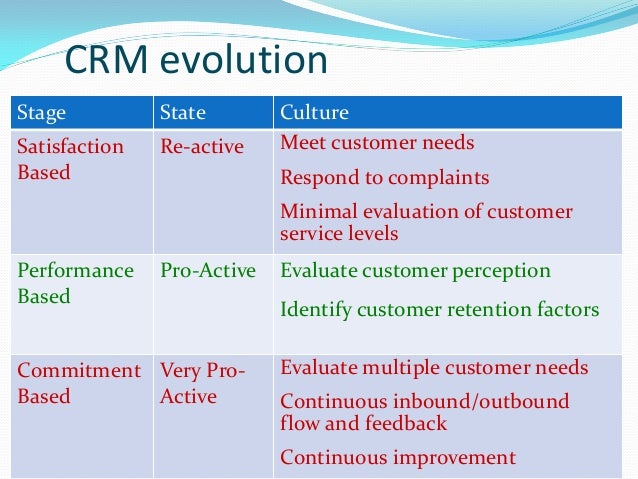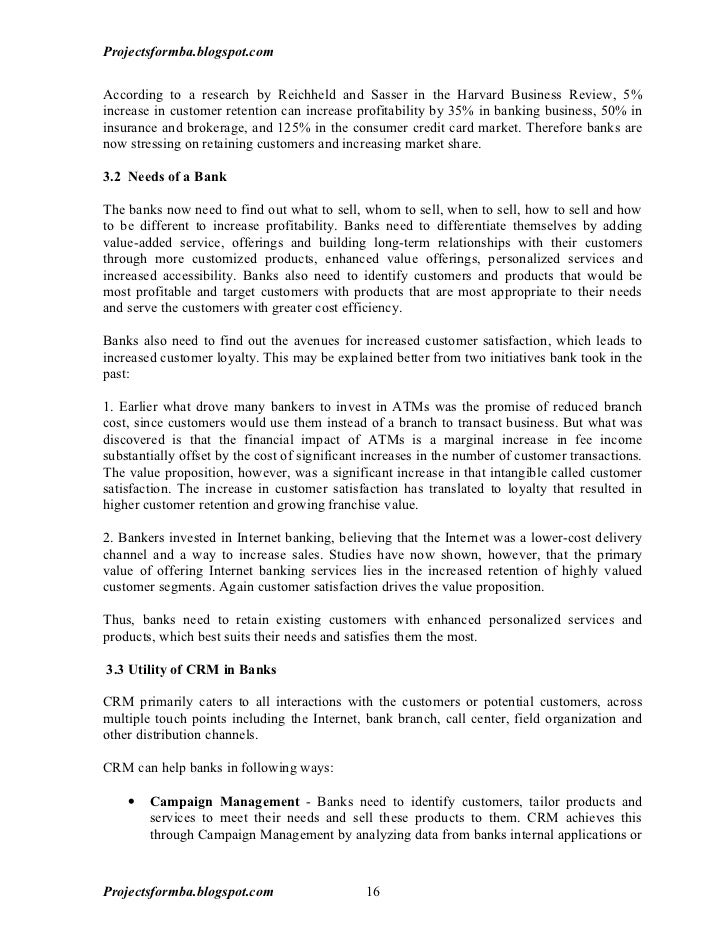
Research Paper on Customer Data Analysis Customer Relationship Management Assignment Customer relationship management is a deliberate strategy that the organization implements to organize its customer relations process. This approach is holistic, meaning that the entire organization becomes involved blogger.comER RELATIONSHIP MANAGEMENT (CRM) PROCESS: It is not clearly known by the businesses that CRM expresses exactly. The resultsof a research conducted by Meta Group, which includes operations, including Sprint, Nortel Networks, Eastman, Kodak, PNC Bank, show that business CRM applications are inaccurate Nov 28, · Check out this awesome Customer Relationship Management (CRM) Research Papers for writing techniques and actionable ideas. Regardless of the topic, subject or complexity, we can help you write any paper!
Customer Relationship Management - A Research Paper
edu no longer supports Internet Explorer. To browse Academia. edu and the wider internet faster and more securely, please take a few seconds to upgrade your browser.
Log In with Facebook Log In with Google Sign Up with Apple. Remember me on this computer. Enter the email address you signed up with and we'll email you a reset link. Need an account? Click here to sign up. Download Free PDF. Customer Relationship Management: A Framework, Research Directions, and the Future.
Sabina Kljajic. Download PDF Download Full PDF Package This paper. A short summary of this paper. Customer Relationship Management: A Framework, Research Directions, and the Future Russell S.
By combining the abilities to respond directly to customer requests and to provide the customer with a highly interactive, a research paper on customer relationship management, customized experience, companies have a greater ability today to establish, nurture, and sustain long-term customer relationships than ever before. The ultimate goal is to transform these relationships into greater profitability by increasing repeat purchase rates and reducing customer acquisition costs.
piphany, Oracle, Broadvision, Net Perceptions, Kana and others have filled this CRM space with products that do everything a research paper on customer relationship management track customer behavior on the Web to predicting their future moves to sending direct e-mail communications, a research paper on customer relationship management. This has required heavy doses of mass advertising and price-oriented promotions to customers and channel members.
Today, the tone of the conversation has changed from customer acquisition to retention. While it is difficult to perfectly distinguish the two activities from each other, the answer is usually that acquisition dominates retention. The impetus for this interest in CRM came from Reichheld4 where he showed the a research paper on customer relationship management increase in profits from small increases in customer retention rates. Other studies done by consultants such as McKinsey have shown that repeat customers generate over twice as much gross income than new customers.
The metrics are divided into three categories: customer attraction, customer conversion, and customer retention. As can be seen, the greatest leverage comes from investments in retention. A problem is that CRM means different things to different people. For some, CRM means direct e-mails. A major purpose of this paper is to provide a managerially useful, end-to-end view of the CRM process from a marketing perspective.
The basic perspective taken is that of the customer, not the company. In other words, what do managers need to know about their customers and how is that information used to develop a complete CRM perspective? The basic model is shown in Exhibit 2 and contains a set of 7 basic components: 1.
A database of customer activity. Analyses of the database. Given the analyses, decisions about which customers to target.
Tools for targeting the customers 5. How to build relationships with the targeted customers, a research paper on customer relationship management. Privacy issues. Metrics for measuring the success of the CRM program. In addition, academics are interested in the CRM space for its research potential. Implications for new research areas will be discussed throughout the paper organized by the components of the CRM framework. Finally, at the end of the paper, we will discuss a number of future directions for CRM, a research paper on customer relationship management.
Creating a Customer Database A necessary first step to a complete CRM solution is the construction of a customer database or information file. For Web-based businesses, this should be a relatively straightforward task as the customer transaction and contact information is accumulated as a natural part of the interaction with customers.
For existing companies that have not previously collected much customer information, the task will involve seeking historical customer contact data from internal sources such as accounting and customer service. What should be collected for the database? Today, there is an increasing number of customer contact points from multiple channels and contexts.
This should not only include sales calls and service requests, but any customer- or company-initiated contact. This is for segmentation and other data analysis purposes. This part of the information file should contain whether or not the customer responded to a direct marketing initiative, a sales contact, or any other direct contact.
Companies have traditionally used a variety of methods to construct their databases. Durable goods manufacturers utilize information from warranty cards for basic descriptive information.
For example, banks have been in the forefront of CRM activities a research paper on customer relationship management a number of years. Telecom-related industries long distance, wireless, cable services similarly have a large amount of customer information. They built customer records from e-mails, direct mail, telemarketing, and other customer contacts, with descriptive information by department, division, and location.
They collect customer descriptive information and data on trips taken. This enables them to calculate the profit on a per customer trip basis. The challenge is to create opportunities for customer interaction and, therefore, data collection. This can be from running contests to encouraging customer visits to Web sites. Exhibit 3 gives a general framework for considering the problems in database construction.
Firms in the lower right-hand quadrant have the most difficult job because the interact less frequently with customers and those interactions are indirect through channels in nature. Auto and furniture manufacturers are examples here. The other two boxes represent intermediate situations. The point of this framework is that unless you are in the high-direct box, you have to work harder to build a database.
The Thomson Holidays example above is a good illustration of company that used channel incentives to take a low frequency product and still obtain customer information. While some research has started in this direction8, since the database is a significant corporate asset, more work from an accounting perspective is needed. Analyzing the Data Traditionally, customer databases have been analyzed with the intent to define customer segments. A variety of multivariate statistical methods ranging such as cluster and discriminant analysis have been used to group together customers with similar behavioral patterns and descriptive data which are then used to develop different product offerings or direct marketing campaigns.
Their goals are to target the most profitable prospects for catalogue mailings and to tailor the catalogues to different groups. More recently, such segmentation approaches have been heavily criticized. As a result, a new term, lifetime customer value or LCV, has been introduced into the lexicon of marketers.
In words, the profit that a customer has produced for the firm is the sum of the margins of all the products purchased over time less the cost of reaching that customer. These costs include any that can be broken out at the individual customer level such as direct mail, sales calls, etc.
Note that mass advertising would not be part of this formula. It could be assigned to individual customers by computing a per customer dollar amount but because it is the same for each customer, it would not affect the rank ordering of the customers in terms of their profitability. The equation can be used as the basis for LCV calculations by adding forecasts for the major parameters and discounting back.
Generally, this will result in a number a research paper on customer relationship management scenarios for each customer depending upon these assumptions. The equation not only is the basis for LCV, but it can also be used to show where additional profits can be obtained from customers. Other a research paper on customer relationship management of data analyses besides LCV are appropriate for CRM purposes.
Marketers are interested in what products are often purchased together, often referred to as market basket analysis. Complementary products can then be displayed on the same physical page in a hard-copy catalogue or virtual page on a Web site.
A new kind of analysis born from the Internet is clickstream analysis. Do current methods capture all of the aspects of customer value? increase P and J? The results from the analysis could be of various types. If segmentation-type analyses are performed on purchasing or related behavior, the customers in the most desired segments e.
Other a research paper on customer relationship management could also be chosen depending upon additional factors. For example, if the customers in the heaviest purchasing segment already purchase at a rate that implies further purchasing is unlikely, a second tier with more potential would also be attractive.
The descriptor variables for these segments e. In addition, these variables could be matched with commercially-available databases of names to find additional customers matching the profiles of those chosen from the database.
If individual customer-based profitability is also available through LCV or similar analysis, it would seem to be a simple task to determine on which customers to focus. The marketing manager can use a number of criteria such as simply choosing those customers that are profitable or projected to be or imposing an ROI hurdle.
The goal is to use the customer profitability analysis to separate customers that will provide the most long-term profits from those that are currently hurting profits. For less profitable customers, you get automated, menu-driven service. Clearly, the intent was to drive them away. The point is that without understanding customer profitability, these kinds of decisions cannot be made. On what basis should these customer selection decisions be made? One approach would be to take the current profitability based on the above equation.
Customers with high LCV could be chosen; this does a better job incorporating potential purchases. However, these are difficult to predict and you could include a large number of unprofitable customers in the selected group. No matter what criterion is employed, de-selected customers need to be chosen with care.
What is CRM? - A guide to CRM software by Zoho CRM
, time: 6:18Research Paper On Customer Relationship Management (CRM) | WePapers

Nov 28, · Check out this awesome Customer Relationship Management (CRM) Research Papers for writing techniques and actionable ideas. Regardless of the topic, subject or complexity, we can help you write any paper! The purpose of this study was to determine the impact of Customer Relationship Management (CRM) on customer loyalty in the hotel industry. The study was conducted at the Golden Tulip hotel, Accra. The objectives of the study were to determine if (CRM) has an impact on customer loyalty, to determineFile Size: KB Strauss, A. and Corbin, J. (), Basics of qualitative research: Grounded theory procedures and techniques, Sage, London. Verhoef, P. () Understanding the effect of customer relationship management efforts on customer retention and customer

No comments:
Post a Comment